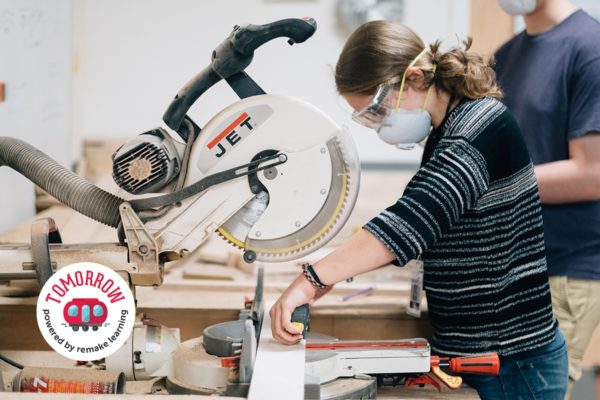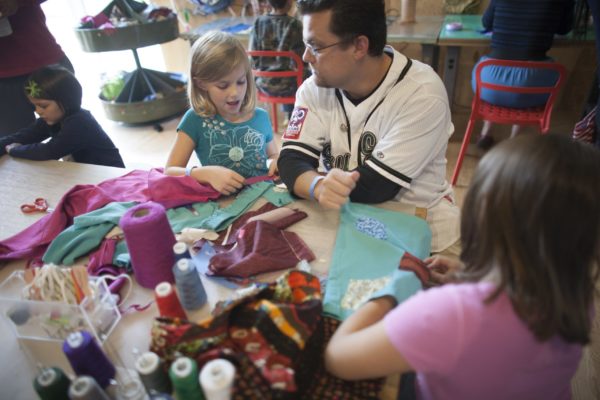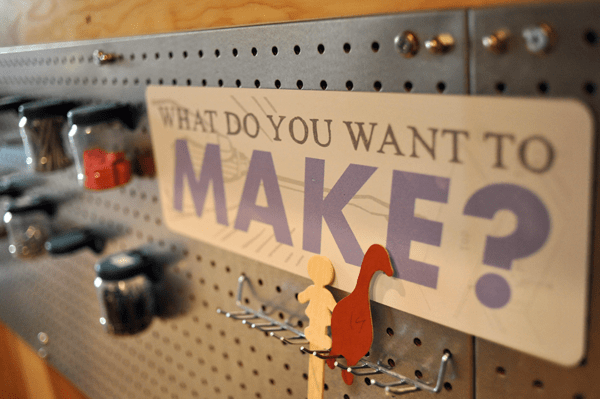
Hands-on learning in Pittsburgh: Hammering a nail, threading a needle, learning a new skill
By Melissa Rayworth
At the MAKESHOP inside the Children’s Museum of Pittsburgh, the small hand of an elementary schooler grips a hammer for the first time.
With supervision, the student carefully pounds a nail into place. Nearby, another child slowly threads a needle and, with the help of a teaching artist, discovers the creative possibilities that grow from joining one piece of fabric to another.
The act of making things is having a moment — one extended and intensified as Americans navigate through various stages of quarantine. Etsy has become a massive marketplace for handmade goods. Knitting is trendy. Instagram and Pinterest are awash in photos of homemade meals and homebaked bread.
These children might assume that such skills, used in everyday life, are something new. New to them, sure. But in some ways, very, very old.
“A lot of these technologies that we don’t consider technologies anymore have been around for centuries,” says Chip Lindsey, senior director of education at the Children’s Museum. “They changed the way we imagined our place in the world and what we could do in it.”
Schools have long played some role in passing on these skills, though some of the courses tended to hover on the periphery of the curriculum — and sometimes were clouded by sexism in the form of efforts to prepare girls to become homemakers. A version of the home economic classes that Baby Boomers and Generation X grew up with still exists today, though it’s now called Family and Consumer Sciences (FCS).
But many districts offer FCS and what we once called “shop class” only as part of narrowly focused career and technical education tracks, says Dr. Carol Werhan, associate professor of FCS education at Purdue University. And in schools that have created some form of “maker space,” the priority tends to be disciplines like coding and robotics.
What if schools emphasized the many ways that hands-on life skills relate directly to core subjects like math, science, and even history and language arts? If all kids got a solid foundation in sewing, cooking and woodworking, what might the world look like?
One of the key steps toward getting there is figuring out how to measure success.
In the Montour School District in McKees Rocks, Pa., fourth-graders had traditionally learned about electricity in science class, then taken a written quiz to see if they understood how circuits work.
Today, Montour students build their own structures using LEGO Education’s bricks and circuits. They tinker with their creations until the lights inside their structure can successfully be turned on.
“Then they have to demonstrate what they’ve learned and they report back to the class,” says Dr. Justin Aglio, Montour’s director of innovation.
The bonus? Along with building problem-solving skills and fueling curiosity about how things work, the students discover that they’re capable of creating impressive things.
“Through all of these practical life skills that they’re learning, children become independent. They become self reliant, great problem-solvers, and they really boost their confidence,” says parenting blogger Misty Hill, founder of The Maternal Hobbyist.
Hill has been teaching her daughter practical life skills since she was a toddler. “Now at age 4, she gets herself dressed, she prepares fruit for breakfast and sets the table, and she puts her own laundry away,” Hill says. And “we’ve added really fun projects like sewing, baking and crafting.”
Some students have the chance to learn these skills at home. But for many, especially those whose parents are grappling with a range of other challenges, schools can help fill in those blanks — even during remote learning.
Aglio says his district was able to keep learning going during the spring quarantine by encouraging hands-on projects. Elementary students were asked to share their sidewalk-chalk art and pictures of elaborate living-room forts they built with pillows and blankets. On Earth Day, they made the dessert known as “dirt” out of crushed cookies and gummy worms.
“We said, ‘If we can get kids engaged in learning by doing things, by being creative at home, by stretching their imaginations, we will continue to have great attendance during this time,’” Aglio says.
It worked. “Our attendance rate was higher at everyday check-ins from March 16 to the end of the school year than when kids actually came to school. And we had some classrooms with perfect attendance.”

The Children’s Museum has seen the same enthusiasm in its virtual afterschool and summer programs. Kids are sent boxes of materials, then taught to use them during live video chats with teaching artists. Once they understand how to use the materials, they can create whatever they wish.
But, Lindsey says, “the one thing that is so critical is that there is a live person that can respond in real time to what the learner is up to.”
Many districts already have the equipment and the teachers to offer a wide range of hands-on classes in school or virtually. But at the high school level, they’re often funded as career and technical education (CTE) and offered mainly to students on particular career tracks.
Some districts do offer what Werhan calls foundational courses, like cooking and nutrition, to the entire student body. But many have shifted their hands-on learning classes to the CTE track. She sees that as a real loss.
So does Lindsay: “In high school, that’s where you see all the tools, right? That’s where you see all the gear that would in any other respect be called ‘a maker classroom.’”
But, he says, because it’s called “CTE,” there’s an entire federal funding stream that powers that type of education. “There’s no reason why that has to be so narrowly focused,” he says.
What might it look like if a district offered hands-on learning to all their high schoolers?
At Montour, they’ve done just that. Each day, the entire high school has three 33-minute classes that can cover any skills that students and teachers find fascinating. “Whatever is best for the students’ interest, whatever is best for the teachers to try to do, we offer at that time,” Aglio says.
By popular demand, the school now has a crocheting class, among other hands-on offerings. And while the classes are only 33 minutes, educators there hope the lessons they teach can last a lifetime.
“We want things to be meaningful and hands-on. I want students to come back to me two years later and say, ‘Hey, Dr. Aglio, remember that thing I did a few years ago and remember what I learned from that?’ That’s my goal.”
This article is part of a series for ‘Tomorrow’ powered by Remake Learning. From May to October, “Tomorrow” will explore – through virtual events, grantmaking, and storytelling – what we can do today to make tomorrow a more promising place for all learners. Follow along or share your hopes for today’s young people using the hashtag #RemakeTomorrow and tagging @RemakeLearning. Learn more about Remake Learning here. And read more “Tomorrow” articles published on Kidsburgh.
